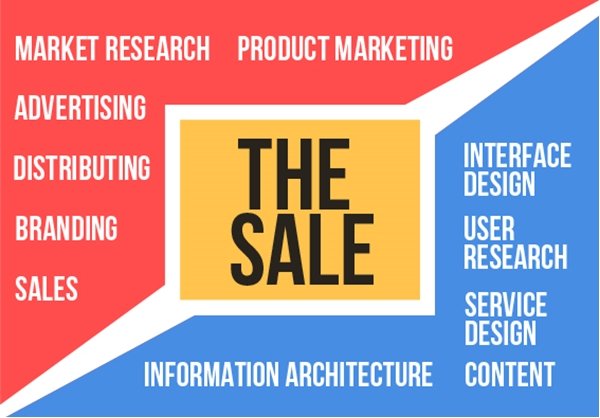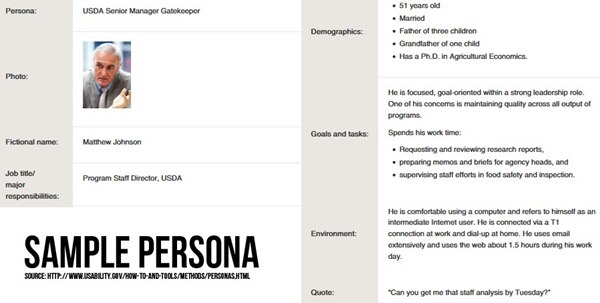For some people, the worlds of marketing and user experience (UX) design seem to be at war because of the old misconception that marketing necessarily means attempting to sell at any cost, and therefore dishonesty, whereas UX means caring about your users and doing what's best for them.
But Marketing, like a movie villain that actually turned out to be a good guy, decided to change its ways and became buddies with the world of good-guy UX. No more bloated language and shifty descriptions: Clarity and transparency are now priority values.
Moreover, today, the two worlds operate on the same principle: Know your users/customers. (The SoDA report from 2014 suggests that Marketing and UX operate dichotomously, yet on the same axis.)
It is simple, really: To make a sale, marketers need to learn as much as possible about their customers and meet customer expectations; and UX specialists want to improve their service so their product meets users' or clients' expectations and is received better (and sells).

Joshua Porter at 52weeksofux concludes: "UX is really just good marketing." And vice versa.
By using the principles and experiences of one field, you can improve the quality of the other. To improve your marketing, think like a UX designer. (See this basic schema of UX design.)
Read on to find out how UX principles can help you become a better marketer.
1. Test everything (including yourself)
You know what UX researchers mostly do? They test. They test clicks, they test pageviews, they test coherence of the writing, they test the colors of the buttons, and they test whether pictures are attractive... The list of things they test could go on and on to fill out the rest of this article.
Our marketing team at my workplace is a great example of how UX and marketing can be combined. Because we offer our clients tools that allow them to test the user experience of their websites and improve the service they offer, it's impossible for our team members to work here without understanding the basics of UX. So I asked one of them if he actually applies UX principles into what he does. Here's his reply:
"Yeah, I do. Once I learned about UX, I realized that not only will it help me in my job but that I used to focus on UX without knowing it. I change my writing from time to time to see how people respond to it, or I change the style of the logos on our website to figure out whether they are appealing. I change [things] all the time and document the results (mostly coming from Google Analytics) to see which option is the best. It's similar to...A/B testing...to see which of the solutions you come up with is more successful. And you need to do that all the time. You do not improve without changing."
Perhaps the best UX principle I can recommend all marketers adopt is the A/B test. (Smashing Magazine has an extensive guide about A/B testing that can aid you in this process.)
For example, a company that trains health professionals determined that its website needed a site redesign. During A/B testing, the company found out that the modern design performed worse than the older design, which converted 19.55% better. The target group of its service consisted of middle-aged people who were more comfortable with the previous design.
The takeaway, then, is to test. Without testing, you cannot verify your ideas or see that other areas need attention instead of those you are studying.
The aforementioned example underscores the importance of A/B-testing: The problem wasn't the design, per se, but the company's lack of awareness of what group constituted its core customers.
That leads us to the next point: Determine your target group.
2. Create user personas
UX experts will instantly recognize the term "user personas." A persona is a representation of the majority of clients or users of your service. User personas are important because they allow the members of your team to enter the right frame of mind when planning and executing both strategy and individual campaigns. A persona also highlights the key traits of your customers, so you don't waste time with efforts that are likely to be irrelevant to your audience.
Both the world of UX and the world of marketing should (actually do) rely on personas. UXers use it to get an idea of who the recipient of the product is and what their basic problems, needs, and motives are.

Source: Usability.gov
Some marketers already follow this principle by using "fictional consumer snapshots," but those are not as extensive as personas. Snapshots sometimes lack occupation, education, habits, motivations, lifestyle, culture, religion, interests, and financial status—all of which are needed to create a profile extensive enough to be useful to your marketing efforts.
(Here's an article about user personas 101 from Smashing Magazine if you want to explore this issue further.)
3. Great user experience attracts people
The aim of marketing is to attract people. When people have positive experiences with a service, they are more likely to return to it. A good way of ensuring that your users indeed do feel positive about your service is to test their user experience—and then improve it.
Applying principles from UX into your marketing approach is good, of course, but applying UX itself is even better. Be sure that whatever you do, it is well suited for your customers: fonts, colors, images, the message itself—all need to be matched perfectly with your target audience (see the previous section...).
Be sure to optimize the user experience. You can do that with various testing methods. (See examples of how testing user experience and usability improved conversion rates of various services. Let them be your inspiration.)
* * *
Marketing and UX have much in common and can learn from each other. At the moment, marketers who should borrow more from UXers, in my humble opinion. What's your take? Head to the comments section!




